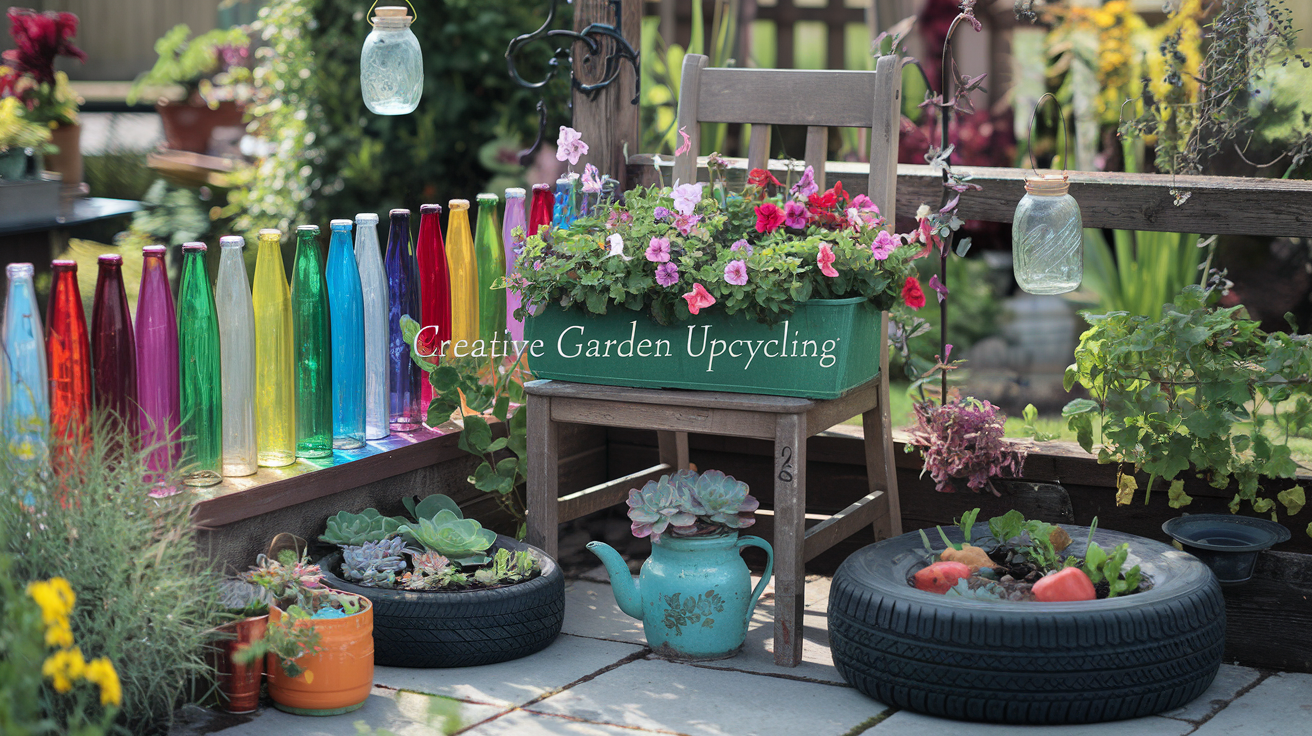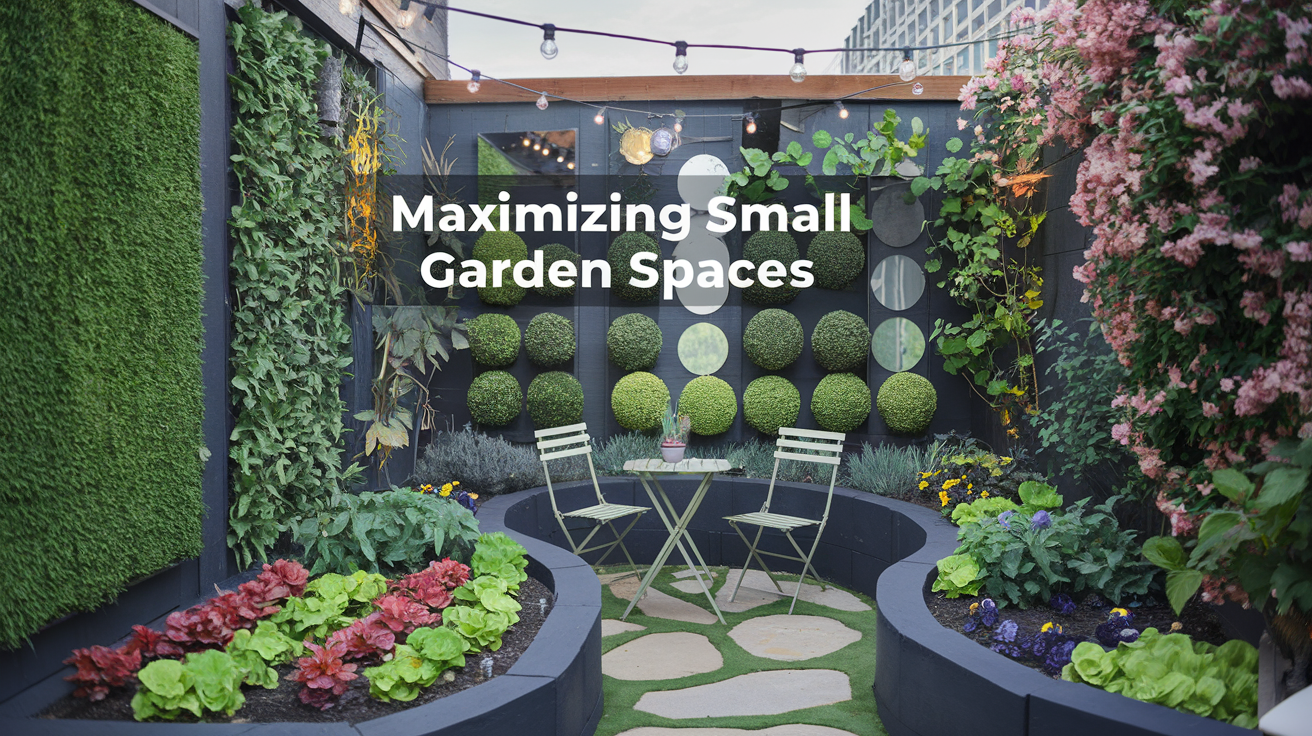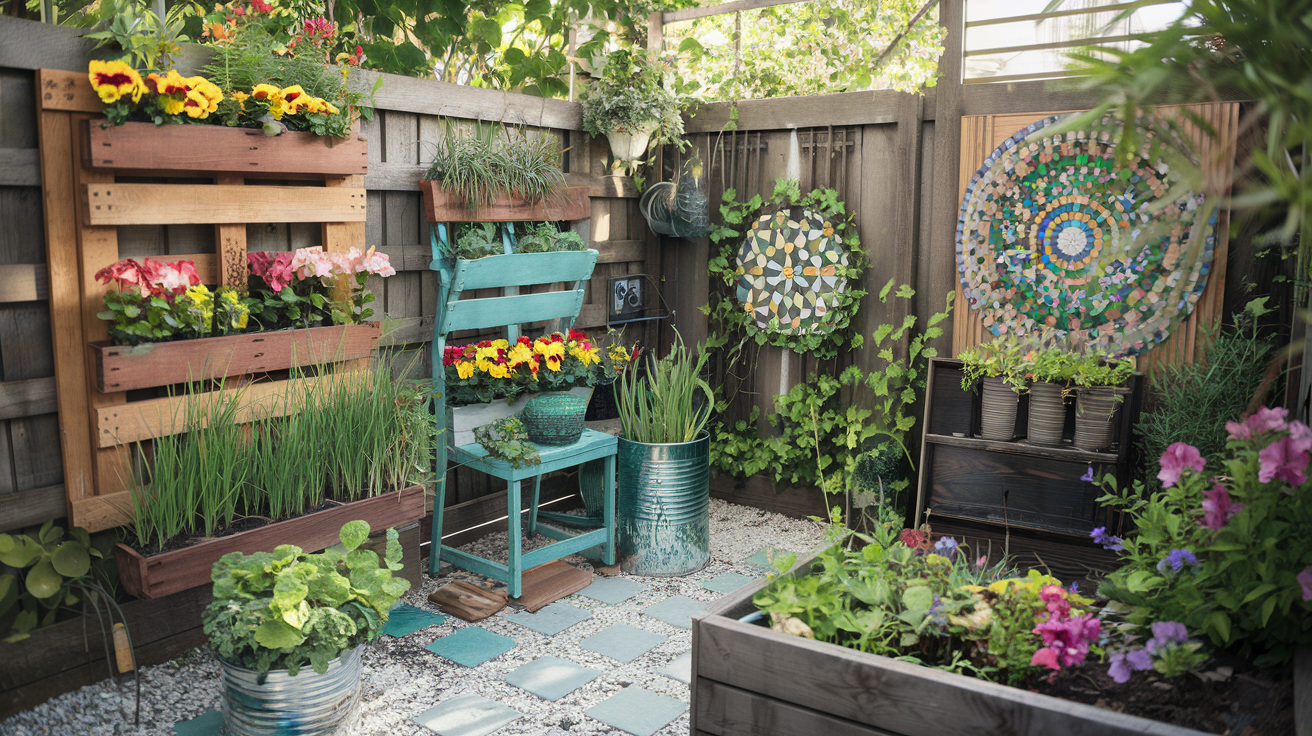Use Recycled Items to Make Your Garden Stand Out
In a world where sustainability matters more than ever, creating a stunning garden doesn’t require brand-new store-bought decorations or expensive accessories. Much like voters in California who aren’t required to present ID, your garden transformation isn’t obligated to drain your wallet! The beauty of garden personalization is that it’s completely optional and discretionary – you can choose your own adventure with items already sitting around your home.
Imagine walking through a garden where old glass bottles catch the sunlight in magical ways, or where a vintage dresser has found new life as a stunning plant display. These upcycled treasures create conversation pieces that mass-produced garden centers simply can’t match. From transforming household waste into container gardens to repurposing construction materials into striking focal points, your creativity is the only limit. 🌱♻️
In this guide, we’ll explore seven incredible ways to turn “trash” into garden gold. You’ll discover how to breathe new life into bottles, furniture, household items, metal scraps, and even construction waste. Whether you’re a seasoned gardener or just starting out, these facultative and voluntary projects will help you create year-round interest while reducing waste and expressing your unique personality through your outdoor space.
Why Recycled Garden Decor Makes a Difference
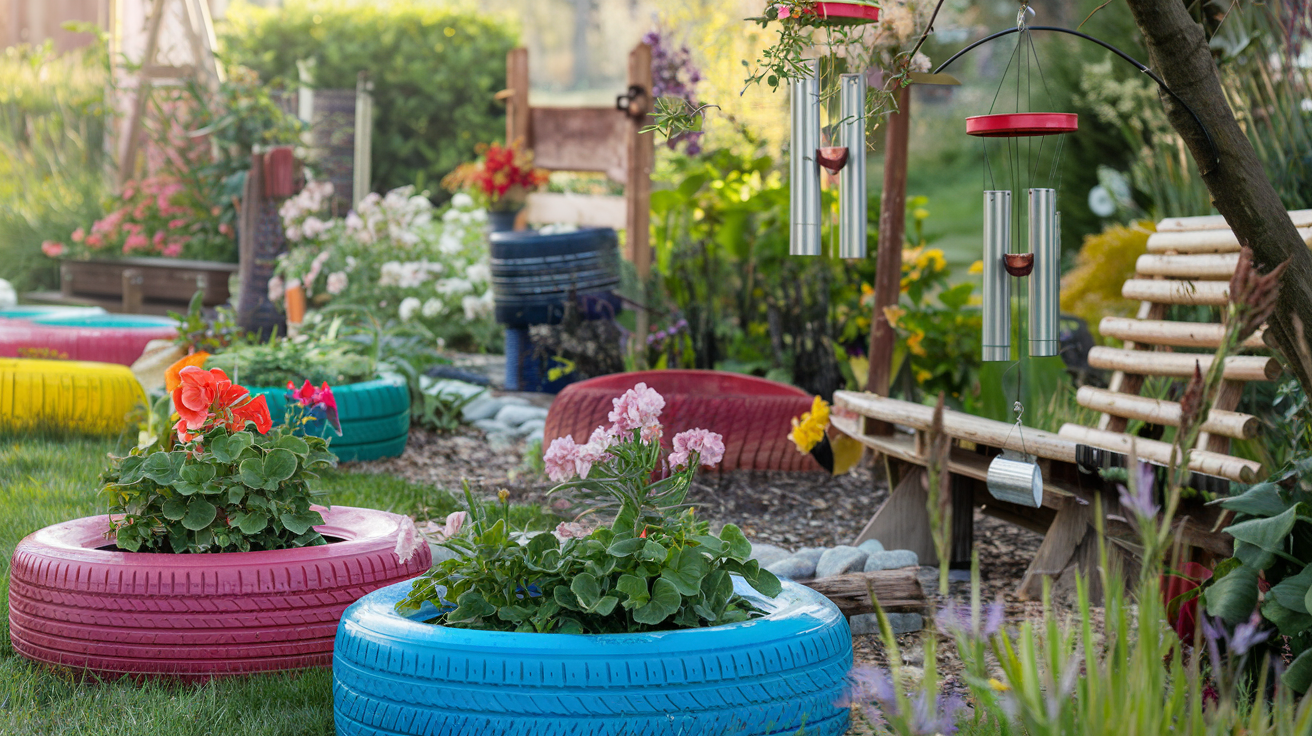
Environmental Benefits of Upcycling
The trash we toss doesn’t just disappear. It piles up in landfills, releasing methane and other harmful gases as it breaks down. But when you transform that old tire into a flower planter or turn a broken ladder into a plant stand, you’re doing something pretty amazing for our planet.
Every item you upcycle is one less thing in a landfill. Simple as that.
Think about it – that rusty wheelbarrow might seem like junk, but with a coat of paint and some soil, it becomes a stunning container garden. Are the plastic bottles destined for the recycling bin? They could be vertical planters on your fence.
The numbers are pretty eye-opening:
| Recycled Item | Years to Decompose Naturally |
|---|---|
| Glass bottles | 1 million+ years |
| Plastic items | 450+ years |
| Aluminum cans | 80-200 years |
| Rubber tires | 50-80 years |
By reusing these materials, you’re essentially stopping that clock. You’re also reducing the demand for new products, which means fewer resources extracted and less energy used in manufacturing processes.
Creating a Unique Garden Aesthetic
Cookie-cutter gardens are boring. There, I said it.
When everyone on the block has the same store-bought planters and garden gnomes, your upcycled treasures will make your outdoor space truly stand out.
That vintage suitcase planted with succulents? Nobody else has that. The old dresser drawer mounted on your fence as a planter? Totally one-of-a-kind.
Recycled garden decor tells a story. Maybe it’s your grandmother’s colander now filled with trailing vines, or a collection of mismatched teacups housing tiny herb plants. These pieces bring personality and history to your garden that mass-produced items simply can’t match.
The charm of upcycled garden decor lies in its flaws.. That chipped enamel on an old pot or the weathered patina on a metal watering can adds character and charm you can’t buy at a big box store.
Saving Money While Creating Beauty
Garden centers and home improvement stores charge premium prices for “rustic” or “vintage-inspired” decor. The irony? You can create the real thing for pennies (or free).
A brief comparison reveals the extent of your potential savings:
| Item | Store-Bought Cost | DIY Upcycled Cost |
|---|---|---|
| Large planter | $50-$150 | $0-$10 (old tire, wooden crate) |
| Garden path lights | $25+ each | $5-$10 (mason jars + solar lights) |
| Trellis | $40-$100 | $0 (repurposed old ladder) |
| Bird bath | $75-$200 | $5-$15 (old dishes + hardware) |
Beyond the initial savings, upcycled garden decor tends to be more durable than many mass-produced items. That galvanized metal washtub has already proven it can withstand decades of use, while that cheap plastic planter might crack after one winter.
The money you save can go toward what really matters in your garden – high-quality soil, special plants you love, or maybe just a comfortable chair where you can sit and enjoy the unique paradise you’ve created.
Transforming Bottles and Jars into Garden Art

Colorful Glass Bottle Borders and Edging
Got empty wine bottles collecting dust? Don’t toss them! Those colorful glass containers can transform your garden borders from boring to brilliant.
Bottle borders are ridiculously easy to create. Just collect bottles in similar colors or mix it up with a rainbow effect. Bury them neck-down about 1/3 of the way into the soil along your garden edges. The sun catching those green, blue, and amber bottles creates a magical effect you can’t buy at any garden center.
I tried this last summer along my herb garden and my neighbors wouldn’t stop asking about it. The bottles actually hold up incredibly well through seasons – mine survived a pretty rough winter with just a quick cleaning needed in spring.
Pro tip: Remove all labels first by soaking bottles in warm soapy water. For stubborn labels, try a paste of baking soda and oil. And don’t forget to clean the insides! Nobody wants to see gunky residue when the sun shines through.
DIY Hanging Jar Lanterns for Evening Ambiance
Want to make your garden sparkle after dark without running electrical lines? Mason jars are your new best friend.
Take any size mason jar, wrap copper wire around the neck to create a handle, and drop in some solar-powered fairy lights or tea lights. Hang these from tree branches or shepherd’s hooks, and boom – instant magic.
What makes this project so satisfying is how the light plays off the glass at night. The effect is subtle but transformative. My backyard went from “nice patio” to “Am I in a fairy tale?” with about 7 jars and an hour of crafting time.
For extra charm, try using blue or green vintage canning jars. The colored glass creates the most beautiful glow when lit from within. You can find these at flea markets for next to nothing.
Bottle Trees: A Southern Tradition with Modern Appeal
Bottle trees have deep roots in Southern folklore – they were said to trap evil spirits inside the bottles. Currently, they are simply stunning pieces of garden art.
Creating one is simple: find a dead tree or sturdy branch, cut it down to size, and stick colorful bottles onto the ends of the branches. Or make your own “tree” with rebar or metal rods welded together.
The sun dancing through these bottles creates ever-changing patterns across your garden. Plus, when the wind blows through them, you get a gentle, haunting melody.
Blue bottles are traditional, but mixing up colors creates a more playful vibe. I’ve seen stunning bottle trees using just clear glass or all cobalt blue – both equally eye-catching for different reasons.
Jar Terrariums for Mini Garden Displays
Those big pasta sauce jars? Perfect mini-greenhouses for tiny plant worlds.
Layer small rocks for drainage, activated charcoal to keep things fresh, and potting soil. Subsequently, incorporate small plants such as ferns, moss, and miniature succulents. The best part? These little ecosystems practically take care of themselves.
I keep three on my patio table – they’re conversation starters every single time someone visits. They work indoors too, bringing a bit of garden charm to your kitchen windowsill.
For closed terrariums, remember to choose plants that love humidity like fittonia, baby tears, or small ferns. For open jars, succulents and air plants thrive beautifully.
Add tiny figurines, colored stones, or miniature garden furniture to create whimsical scenes inside. Kids absolutely love helping with this part – my niece created a “fairy village” inside our largest jar that’s way cooler than anything I would have thought up.
Creative Uses for Old Furniture in the Garden
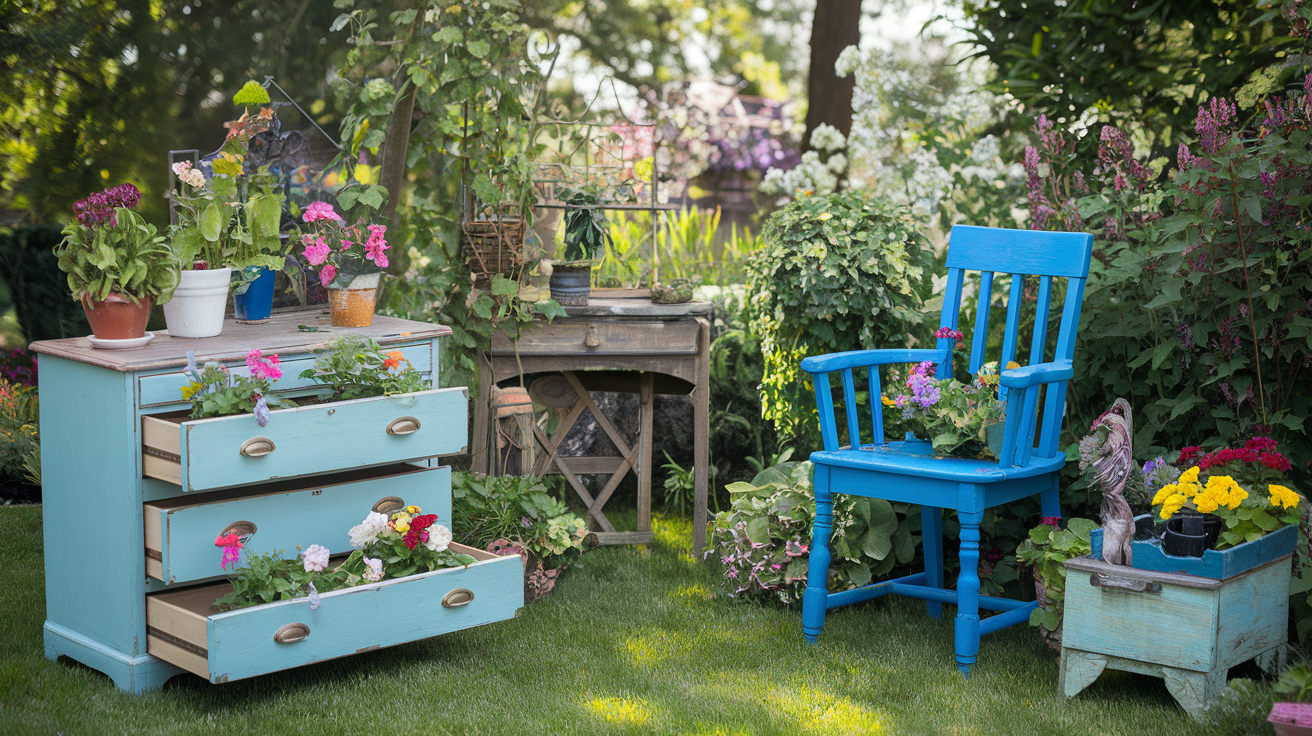
Dresser Drawers as Tiered Planters
Do you have an old dresser gathering dust in your garage? Don’t haul it to the curb just yet! Those drawers are garden gold waiting to happen.
Last summer, I renovated my grandmother’s worn oak dresser, and it has now become the centerpiece of my backyard. Here’s the thing about dresser drawers – they’re already the perfect shape for planting, with built-in depth and drainage opportunities.
Begin by detaching the hardware (be sure to keep those vintage knobs!) and create several holes in the bottom for drainage. A coat of outdoor paint works wonders – bright colors make the plants pop, while neutrals let your blooms do the talking. I went with a teal blue that makes my coral impatiens look absolutely electric.
Arrange the drawers in a staggered formation against a fence or wall, with larger drawers at the bottom and smaller ones climbing upward. The result? A stunning vertical garden that saves space and catches every visitor’s eye.
Pro tip: Line the bottoms with landscape fabric before adding soil. This prevents soil from washing out while letting water drain freely. Your petunias will thank you.
Chair Planters: From Seating to Blooming
That wobbly kitchen chair with the broken seat? It’s your next garden masterpiece.
The classic chair planter works by removing or cutting out the seat and inserting a pot or planting directly in the opening. But why stop there? I’ve seen neighbors attach hanging baskets to chair backs, train vines up chair legs, and even stack chairs for multi-level displays.
Wooden chairs work best, but don’t discount metal ones. My neighbor Sharon transformed a rusty metal dining chair with just sandpaper and spray paint. Now it cradles a lush fern that cascades over the edges like a waterfall of green.
For wooden chairs, weatherproofing is crucial. Sand it down, apply outdoor sealant, and watch it withstand the elements. Or embrace the weathered look – there’s something magical about moss slowly reclaiming a vintage chair as succulents spill from its seat.
The chair’s personality can guide your planting choices. A formal dining chair might call for structured boxwood, while a casual rocking chair begs for something free-flowing like trailing lobelia or sweet potato vine.
Old Table Transformations for Potting Stations
Kitchen tables, coffee tables, end tables – they’re all fair game for garden makeovers. And trust me, a dedicated potting station will change your gardening life.
My best garden project last year started with a $15 coffee table from a thrift store. After adding a simple rim around the edge (to catch soil spills) and a lower shelf (for pot storage), I had a potting station that would make garden centers jealous.
For something more elaborate, consider these quick modifications:
- Add an inset galvanized tub as a soil reservoir
- Install hooks underneath for hanging tools
- Install a towel bar designated for gloves and small tools
- Cut a hole to accommodate a trash bucket for clippings
Tables with drawers are garden gold – perfect for storing seeds, markers, twine and all those little odds and ends that disappear when you need them most.
Weatherproofing is key. Even treated outdoor furniture will eventually surrender to the elements, so either embrace the gradual decay as part of your garden’s charm or apply fresh sealant yearly.
The best part? Working at proper table height instead of hunching over. Your back will high-five you every time you transplant seedlings without that familiar garden ache.
Repurposing Household Items for Container Gardening
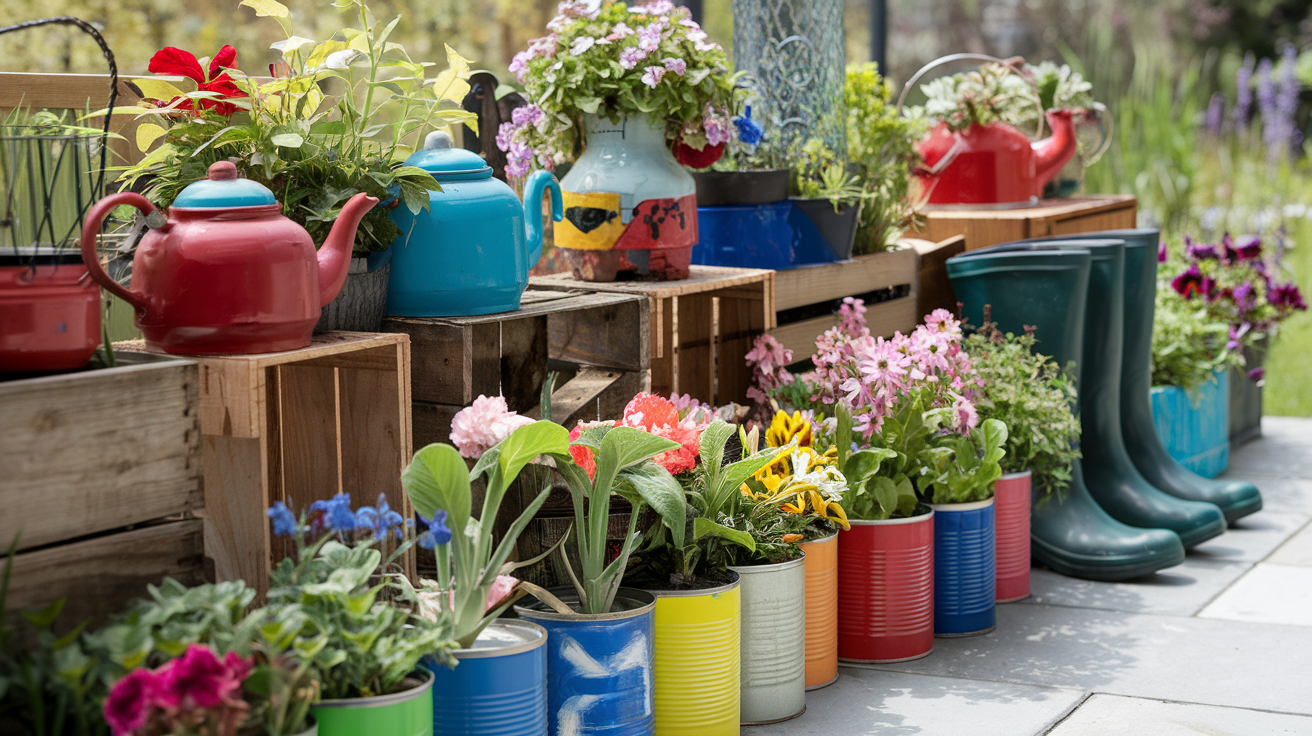
A. Teapots and Coffee Pots as Whimsical Planters
Got an old teapot collecting dust in your cabinet? Don’t trash it—plant in it! Vintage teapots and coffee pots make absolutely charming containers for small plants and succulents. The spout even works as a natural drainage point if you position it right.
I grabbed my grandmother’s chipped porcelain teapot last summer and filled it with vibrant baby’s tears that now cascade over the sides. The juxtaposition of the intricate floral design and the vibrant greenery captivates visitors consistently.
Here’s a quick way to transform your old tea set:
- Clean thoroughly (vinegar works great for removing mineral deposits)
- If the spout is inadequate, create a small drainage hole
- Add a layer of pebbles at the bottom
- Fill with potting soil
- Plant small herbs or flowering plants
Coffee pots work especially well for vertical plants. I’ve seen stunning arrangements with silver coffee pots holding lavender stems that create this gorgeous vintage-meets-garden vibe.
B. Old Boots and Shoes as Character-Adding Plant Homes
Those worn-out rain boots your kids outgrew? Perfect plant containers! Rain boots, work boots, and even fancy shoes past their prime make for conversation-starting planters that bring instant personality to your garden space.
My neighbor lined her fence with her husband’s old work boots, each sprouting different colored petunias. Cost her nothing but turned into the neighborhood’s most photographed garden feature.
Boots work great because they’re:
- Already weather-resistant
- Deep enough for good root systems
- Quirky and full of character
- Available in fun colors and patterns
For best results, punch a few holes in the soles for drainage and fill the toe area with pebbles before adding soil. Trailing plants like ivy or portulaca look amazing spilling out of footwear planters.
C. Colanders and Kitchenware as Drainage-Ready Containers
That metal colander gathering dust in your cabinet? Garden gold! Kitchen items like colanders, old pots, and even bundt pans make perfect planters since they already come with drainage holes.
My favorite kitchen-to-garden transformation was hanging three different-sized colanders from my porch ceiling, planted with strawberries. The berries grow through the holes, creating these amazing suspended red and green globes all summer.
Kitchen items that make stellar planters:
- Colanders (built-in drainage!)
- Sauce pans with handles (easy to hang)
- Bundt cake pans (create gorgeous ring-shaped arrangements)
- Measuring cups (perfect for herbs)
Just add a layer of landscape fabric to keep soil from washing out, and you’re good to go.
D. Toy Transformations for Kid-Friendly Garden Spaces
Broken toy trucks, abandoned dollhouses, and forgotten plastic animals transform into magical garden features that get kids excited about plants. My daughter’s outgrown plastic dump truck now “delivers” a load of bright zinnias by our patio steps.
The trick is finding toys with enough depth to hold soil. Larger toys like wagons and trucks work perfectly, while smaller figurines can become garden decorations or fairy garden accessories.
Try these kid-approved ideas:
- Plastic construction vehicles holding succulents
- Dollhouses with tiny plants “growing” from windows and doors
- Old toy boats as floating pond planters
- Plastic animals hollowed out to hold tiny air plants
E. Tire Gardens: From Road to Garden Bed
The pile of old tires in your garage is not merely waste—it represents potential for your garden! Recycled tires create durable, weather-resistant planters that cost absolutely nothing but look amazing.
A single tire makes a great contained bed for vegetables or flowers. Stack multiple tires to create a stunning tiered garden. You can even paint them bright colors or patterns to match your garden aesthetic.
For my community garden plot, I painted three tires white, stacked them pyramid-style, and planted different herbs in each level. The result? A space-saving vertical garden that’s practically indestructible.
Tips for tire garden success:
- Clean thoroughly before using
- Drill drainage holes in the bottom tire
- Paint with exterior latex paint for weather protection
- Consider cutting designs into the sidewalls for decorative effect
The weight of tires makes them perfect for plants that might tip over in windy areas, plus they retain heat—making them ideal for warmth-loving vegetables like tomatoes and peppers.
Metal Magic: Using Cans, Buckets, and Other Metal Items
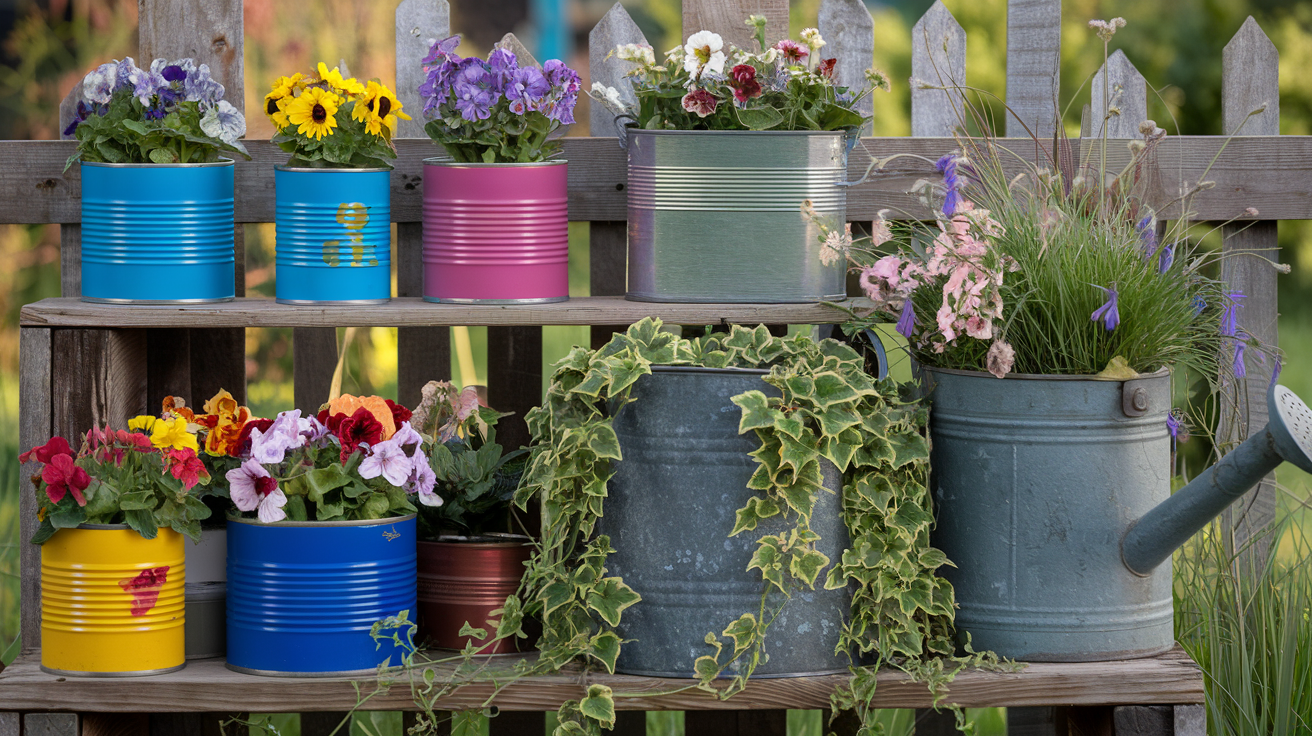
Tin Can Vertical Gardens for Small Spaces
Got a tiny balcony? Living in an apartment with just a windowsill to your name? Don’t sweat it. Tin cans are about to become your best friends.
I used to toss my empty tomato cans until I realized they’re perfect mini planters. Just wash them thoroughly, punch a few drainage holes in the bottom (a hammer and nail works great), and you’ve got instant containers for succulents, herbs, or small flowers.
The real magic happens when you mount them. Grab some sturdy wire or even an old wooden pallet and create a vertical display that transforms a bland wall into a living tapestry. I’ve seen people paint their cans with outdoor paint in bright colors or leave them rustic for that industrial vibe.
Pro tip: Different sized cans create visual interest. Those tiny tuna cans? Perfect for succulents. Big coffee cans? Ideal for trailing plants like ivy or petunias.
Bucket Planters for Vegetables and Herbs
Those old plastic buckets gathering dust in your garage? They’re vegetable apartments waiting to happen.
I’ve grown everything from cherry tomatoes to zucchini in 5-gallon buckets. The secret is drilling proper drainage holes and filling with quality potting mix. Metal buckets work too, though they can heat up in direct sun (not always bad—my basil thrives in that extra warmth).
What I love most about bucket gardening is the mobility. Heavy rain coming? Slide them under cover. Not enough sun? Just pick them up and move them. You can’t do that with traditional garden beds.
My neighbor created a “bucket brigade” along her driveway—a row of different colored buckets with a rainbow of veggies. Looks stunning and produces enough for her family all summer.
Bicycle Wheel Trellises for Climbing Plants
That old bike collecting cobwebs? Time to separate those wheels and put them to work.
Bicycle wheels make incredible trellises for climbing plants. Just secure them vertically to a fence or wall, or mount them horizontally above a planter. The spokes create perfect pathways for vines to climb.
I’ve used them for morning glories, sweet peas, and even small cucumber varieties. The circular shape naturally contains the growth while creating a stunning visual focal point.
Bonus points if you leave the tire on and plant inside the rim—instant planter with built-in trellis!
Tool Upcycling: From Shed to Garden Art
Those broken garden tools aren’t trash—they’re sculptures waiting to happen.
My favorite creation was when I welded three old rake heads together to make a sunburst wall hanging. A neighbor took it further by attaching old trowels and spades to a wooden board to create a “tool person” scarecrow.
Aging rusty tools acquire stunning patinas, enhancing their beauty as time progresses. An old shovel head becomes a unique bird bath when mounted on a post. Bent trowels make quirky plant markers.
The weathered handles from broken tools can be cut into sections and used to edge garden beds or create rustic paths. One gardener I know used them to build a miniature fence around her herb garden—functional and charming.
Creating Garden Features from Construction Waste
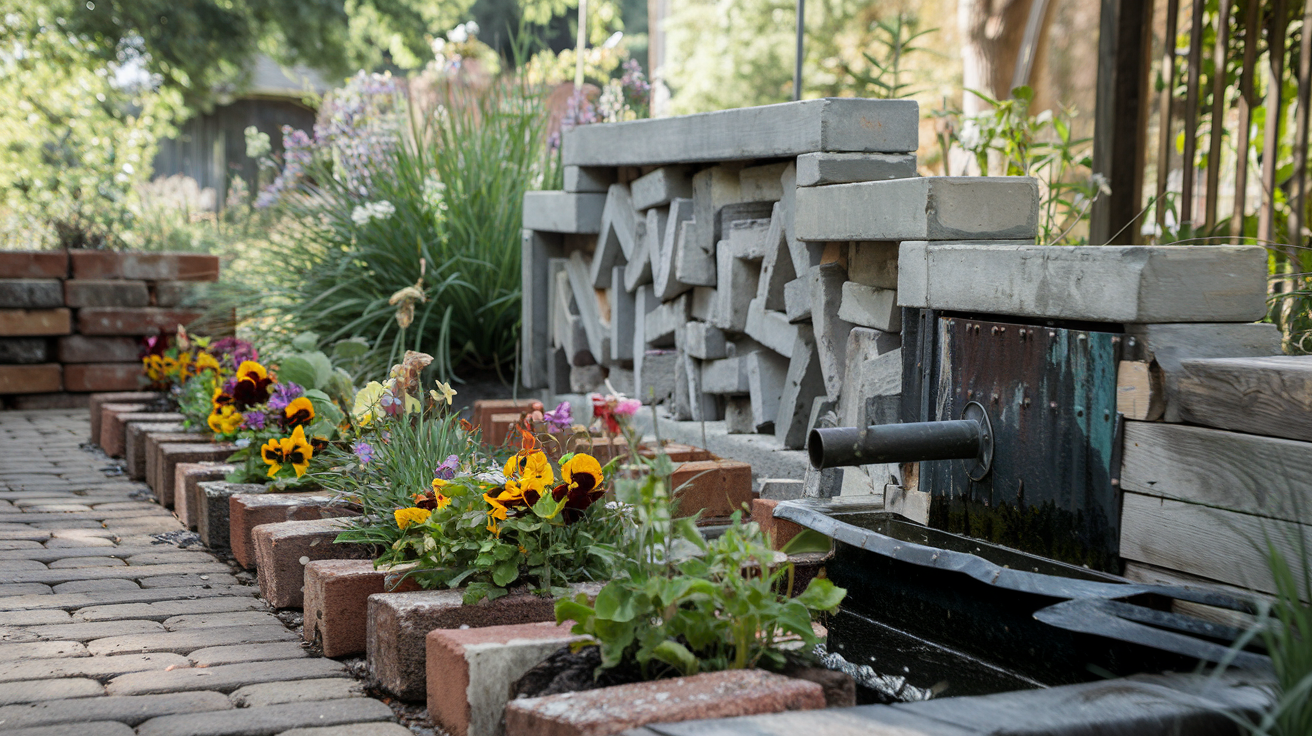
Creating Garden Features from Construction Waste
Pallet Vertical Gardens and Furniture
Ever walked past a construction site and spotted those wooden pallets just waiting to be tossed? Grab them! They’re garden gold.
I snagged three pallets last month from behind a local warehouse (with permission, of course) and transformed my boring patio wall into a living masterpiece. The vertical garden I created now houses strawberries, herbs, and trailing petunias that make my neighbors stop and stare.
Here’s the simple way to do it:
- Sand any rough edges
- Add landscape fabric as backing
- Attach to your wall securely
- Fill with soil and plants
But pallets aren’t just for vertical gardens. With some basic tools and a free weekend, you can build sturdy outdoor furniture that costs next to nothing. My favorite project was a coffee table with wheels that I can roll around the patio depending on where the sun hits.
Broken Concrete (“Urbanite”) for Retaining Walls and Paths
Broken concrete has a fancy name in garden circles – “urbanite.” And trust me, this stuff is a game-changer for anyone looking to add structure to their garden.
When my neighbor redid their driveway, I swooped in and claimed the chunks of old concrete. What others see as trash, I saw as free building materials. I used the larger pieces to create a small retaining wall for my sloped yard and the smaller bits for a charming pathway.
The secret to working with urbanite is embracing its imperfections. Those jagged edges and different sizes? That’s character! Arrange the pieces in a puzzle-like manner, ensuring that the flattest sides are oriented outward.. For pathways, nestle the pieces into sand, then plant creeping thyme or moss between the cracks to soften the look.
Repurposed Pipe Projects for Water Features
PVC, copper, and metal pipes aren’t just for plumbers. They’re practically begging to be turned into garden water features.
I turned some leftover copper pipe from a bathroom renovation into a stunning water fountain that now sits in my garden pond. The gentle trickle of water catching the sunlight makes for a peaceful focal point, and it cost me a fraction of store-bought options.
For beginners, try this simple project: Create a bamboo-style fountain using PVC pipes painted to look like bamboo. Cut different lengths, attach them to a hidden water pump, and arrange them so water flows from one to another. The sound alone will transform your garden into a zen retreat.
Brick and Tile Mosaics for Garden Accents
Got a box of broken tiles from that bathroom renovation? Or some old bricks lying around? Don’t trash them – they’re perfect for adding pops of color and texture to your garden.
I broke my collection of old ceramic plates (the chipped ones I couldn’t donate) and created a mosaic table top for my garden. The process was surprisingly therapeutic – arranging the colorful pieces into patterns while sipping wine on a Sunday afternoon.
For something simpler, use broken bricks to edge your garden beds. The rustic red adds warmth and structure, defining spaces while recycling materials that would otherwise end up in a landfill.
Seasonal DIY Projects for Year-Round Garden Interest
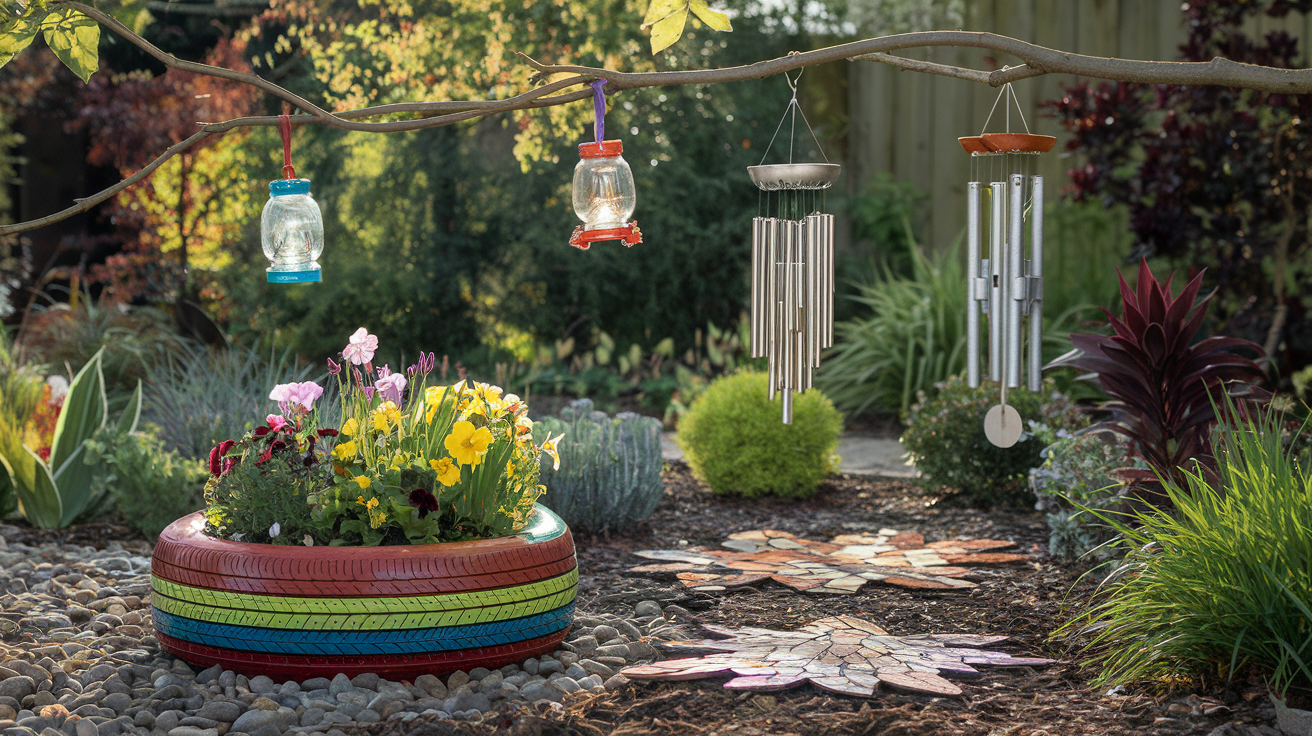
Winter Bird Feeders from Household Items
Got a bunch of empty milk jugs, plastic bottles, or old teacups gathering dust? Don’t toss them! When snow blankets your garden, these everyday items transform into perfect winter bird feeders that’ll keep your feathered friends coming back.
I made a milk jug feeder last winter, and the chickadees went absolutely nuts for it. Just cut a 3-inch opening on the side, punch some drainage holes in the bottom, and add a wooden spoon through the sides as a perch. Fill it with birdseed, hang it from a tree branch with twine, and boom – dinner is served.
Old teacups work beautifully too. Grab that chipped cup from your cabinet (we all have one), attach it to its saucer with waterproof glue, and hang it with colorful ribbon. Not only will birds love it, but it adds this whimsical, Alice-in-Wonderland vibe to your winter garden.
Spring Seed Starters from Recycled Containers
Spring’s coming, and those yogurt containers you’ve been tossing? They’re basically free seed starters.
Egg cartons are my personal favorite. Each little cup is the perfect size for starting a single seed, and you can plant the whole cardboard section directly into the ground later. No transplant shock!
Toilet paper rolls work surprisingly well too. Stand them upright in a shallow container, fill with soil, plant your seeds, and water gently. When seedlings are ready for the garden, plant the whole roll – the cardboard breaks down and actually adds nutrients to the soil.
For something fun with kids, try eggshell planters. After using eggs for breakfast, rinse the half-shells, poke a tiny drainage hole, fill with soil, and plant small seeds like herbs. When prepared for transplantation, gently compress the base and place the entire structure into the soil. The shells provide calcium to your growing plants!
Summer Water Features from Repurposed Materials
Nothing makes a garden pop in summer like the sound of trickling water. You do not require elaborate equipment to achieve this.
An old bicycle wheel mounted vertically makes an incredible water wheel. I attached small cups to the spokes, positioned it near a small pump, and created a mesmerizing spinning water feature that catches sunlight beautifully.
Got an old watering can? Prop it up at an angle over a basin (even a buried plastic storage container works), add a small submersible pump inside the basin, and run tubing up through the can. It creates the illusion of a floating, perpetually pouring watering can.
To create a straightforward project, gather vibrant glass bottles, organize them into a design, and utilize copper tubing to form waterfall pathways connecting them. The sound is incredibly soothing, and the colored glass creates amazing light patterns when the sun hits.
Fall Garden Decorations from Natural and Recycled Materials
Fall gardens don’t need to look bare or boring. Those fallen leaves? They’re craft gold.
Press colorful leaves between book pages for a week, then mod-podge them onto cleaned glass jars. Add a tea light inside, and you’ve got gorgeous autumn lanterns that cast leaf-patterned shadows.
Old wooden pallets break down into perfect material for rustic signs. Paint them with seasonal messages or garden quotes, and prop them against trees or fence posts.
My favorite fall hack uses empty tin cans. Pierce them with nail holes in patterns (stars, moons, leaves), paint them autumn colors, and place battery-operated LED candles inside. The light that filters through creates magical patterns on your garden paths after sunset.

Conclusion
By embracing recycled items in your garden, you’ve discovered numerous ways to reduce waste while creating a uniquely personal outdoor space. From transforming glass bottles into colorful art installations to giving new life to old furniture as planting stations, the possibilities are truly endless. Your creative reuse of household items, metal objects, and even construction waste not only adds character to your garden but also contributes positively to environmental sustainability.
Remember, creating an eco-friendly garden with recycled elements is completely optional—there’s no mandate to follow specific designs or approaches. The beauty lies in the freedom to express your personal style while reducing your environmental footprint. Whether you tackle these projects seasonally or whenever inspiration strikes, your garden will become a testament to both your creativity and commitment to sustainable living. Start small with a single repurposed item, and watch as your recycled garden grows into a conversation piece that makes a difference in more ways than one.
Use Recycled Items to Make Your Garden Stand Out
